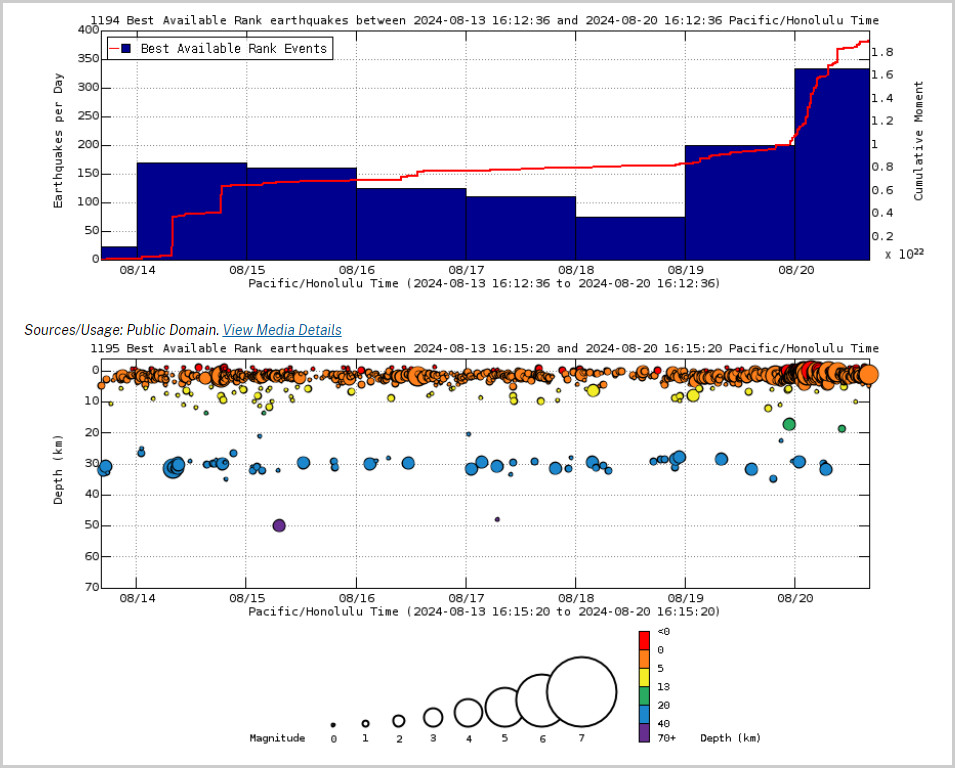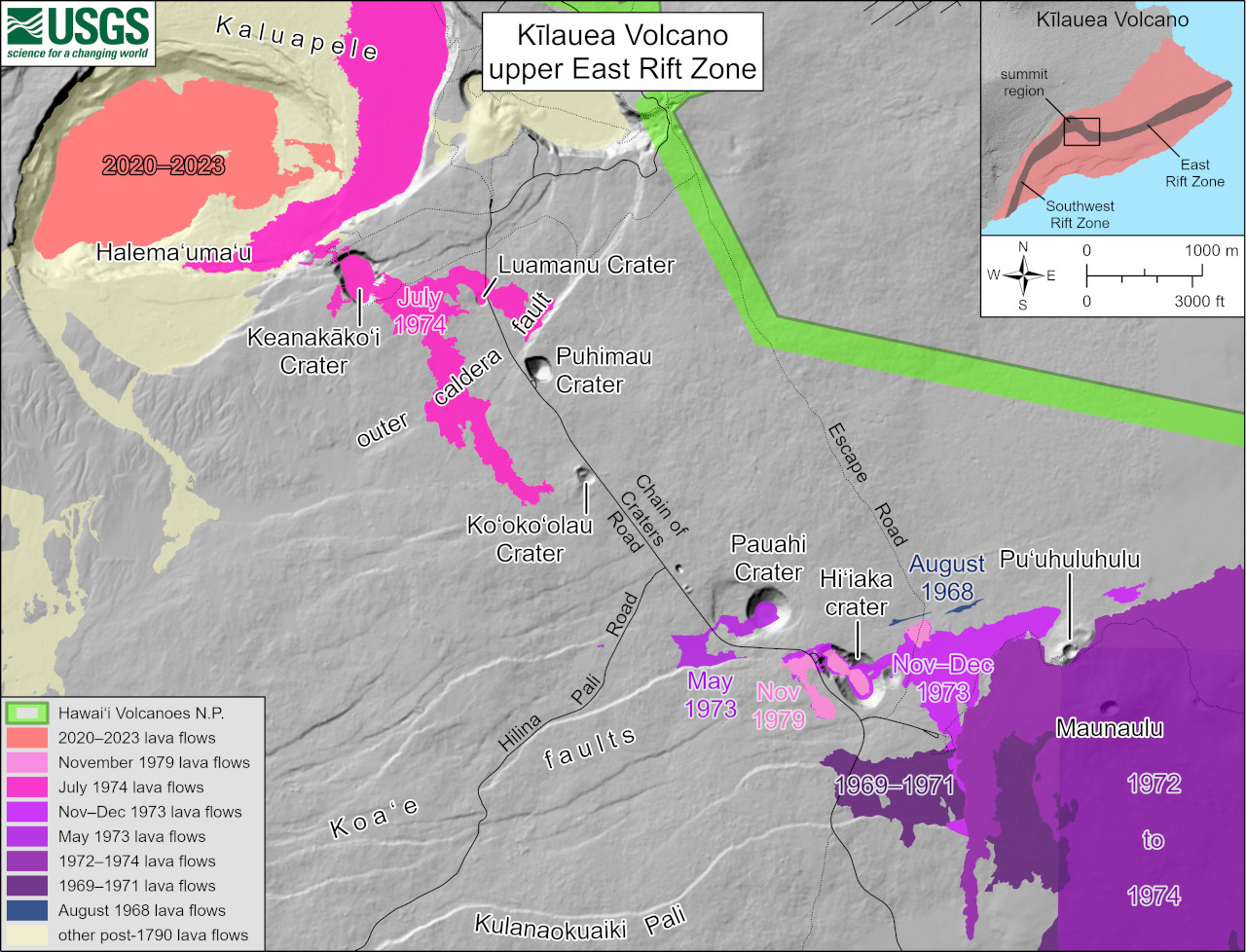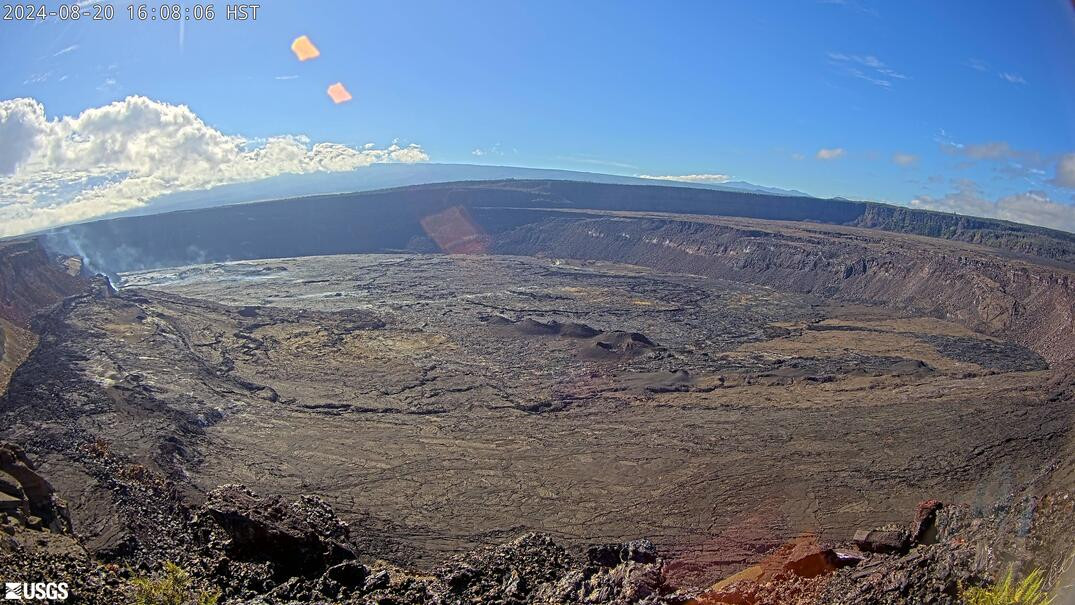(BIVN) – A swarm of earthquakes and increased rates of ground deformation began last night at Kīlauea’s upper East Rift Zone, scientists say, although there are no signs of imminent eruption at this time.
Kīlauea is not erupting and the USGS Volcano Alert Level remains at ADVISORY.
The uptick in activity that started at approximately 9 p.m. Monday night peaked at around 2 a.m. Tuesday morning, and continued at a reduced rate throughout the day.
“Changes in the character and location of unrest can occur quickly, as can the potential for eruption, but there are no signs of imminent eruption at this time,” the USGS Hawaiian Volcano Observatory wrote in a Tuesday update. “There are no significant changes in activity in the lower East Rift Zone and Southwest Rift Zone.”
There have been hundreds of earthquakes recorded at Kīlauea over the past day, mostly under the upper East Rift Zone.

Above Top: Number of earthquakes per day during the past week (blue bars). The red line is the cumulative moment (energy) release. Bottom: Depth of earthquakes during the past week in the area shown on the map above. Depth is reported relative to sea level, which is equal to a depth of zero on the above plot. On both figures, circle-size represents magnitude, and color indicates depth. (USGS graphs)
From the USGS HVO on Tuesday, August 20:
Summit Observations: Approximately 16 earthquakes were detected beneath Kaluapele (Kīlauea’s summit caldera) over the past 24 hours. Most were located south of Halema‘uma‘u and near Keanakākoʻi Crater at depths of 1–3 km (0.6–1.9 mi) below the ground surface with magnitudes of less than M2.0. Rates of deformation at the summit remained relatively low with minor local deflation, likely in response to unrest in the upper East Rift Zone (UERZ). An overall gradual inflationary trend continues to be seen on GPS instruments around the summit region. The most recent measurement of the summit’s SO2 emission rate was approximately 70 tonnes per day on August 13, 2024.
Rift Zone Observations: Over the past 8 hours, there have been approximately 200 earthquakes beneath Kīlauea’s UERZ region, extending from Puhimau Crater southeast to Maunaulu. Activity peaked between 1:00 and 2:00 AM HST, and earthquakes have been occurring at decreasing rates since then. Most earthquakes have been smaller than M2.0, though there were 6 events larger than M3.0. The largest earthquake was a M3.7 at 2:21 AM HST. Events have remained at depths of 1–3 km (0.6–1.8 miles) beneath the surface. Most earthquakes have been too small to feel, but several were reported felt in Hawaiʻi Volcanoes National Park and surrounding communities.
Earthquake activity has been accompanied by elevated rates and changing patterns of ground deformation recorded by the ESC tiltmeter in Kīlauea’s UERZ. Rates of deformation have decreased since about 4:30 AM HST but remain elevated. Tiltmeters in Kīlauea summit region (instruments SDH, southwest of the summit, and UWE, northwest of the summit) have shown minor deflationary trends since about midnight, likely associated with the UERZ unrest.

USGS: “This reference map depicts the features on Kīlauea’s upper East Rift Zone. Chain of Craters Road in Hawaiʻi Volcanoes National Park follows the path of the upper East Rift Zone. Pit craters, thermal areas, and lava flows are evidence of a long history of magma moving along this rift zone pathway. Upper East Rift Zone eruptions have typically occurred near the southeast margin of Kaluapele, or where the upper East Rift Zone meets the middle East Rift Zone near Pauahi Crater.”
Activity in the middle East Rift Zone (MERZ) remains low with approximately 25 earthquakes detected in the past 24 hours. Earthquake locations are scattered between Maunaulu and Puʻuʻōʻō within Hawaiʻi Volcanoes National Park. Depths range from 1–3 km (0.6–1.9 mi) below the ground surface with magnitudes less than M2.0. There has been no significant change in deformation at the POC tiltmeter overnight. GPS instruments continue to record inflation in the region.
Measurements from continuous gas monitoring stations downwind of Puʻuʻōʻō in the middle East Rift Zone—the site of 1983–2018 eruptive activity—remain below detection limits for SO2, indicating that SO2 emissions from this area are negligible.
At this time, there is no evidence of seismicity or ground deformation beneath the lower East Rift Zone, and Southwest Rift Zone activity remains low. Current activity is restricted to the summit and upper East Rift Zone region.
Analysis: UERZ unrest over the past night may represent another pulse of magma being supplied to the UERZ, following the intrusive event that occurred near Pauahi Crater over July 22–25, 2024. Currently, the MERZ has not shown signs of increased unrest; however, magma has recently re-established a path to Kīlauea’s MERZ. Unrest could potentially extend to the MERZ with continued magma supply.
There have been no new closures reported within Hawaiʻi Volcanoes National Park in response to the latest Kīlauea activity.


by Big Island Video News4:45 pm
on at
STORY SUMMARY
HAWAIʻI VOLCANOES NATIONAL PARK - Last night's spike in activity may represent another pulse of magma being supplied to the upper East Rift Zone, following the intrusive event that occurred in July.